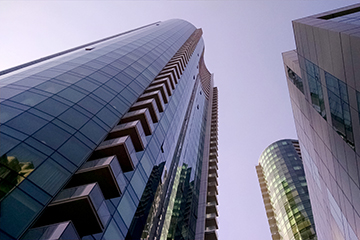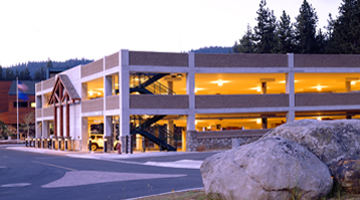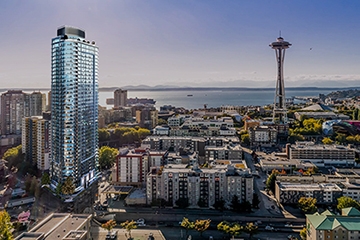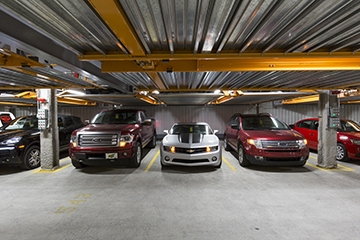Taking the Mystery Out of Mechanical and Automated Parking
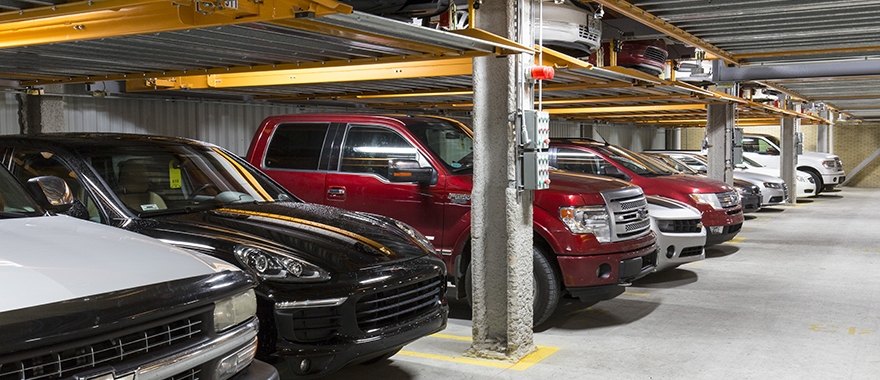
What makes a mechanical or automated parking solution a viable alternative to traditional parking? In an increasing number of urban areas, site constraints such as limited footprints, height restrictions, the cost of subterranean excavations, etc. can make the cost of providing sufficient parking prohibitive or even impossible. When one or more of these conditions are present, mechanical and automated parking solutions can provide a more cost effective alternative by shrinking the parking footprint or creating more density within the same footprint.
However, determining the value that these solutions can provide is a complex question that requires careful consideration of a number of different factors aside from the cost of purchasing a particular system. Design considerations that can increase construction costs, maintenance considerations that can increase ongoing costs, level of service provided to the user and performance needs are all vital components that must be evaluated to create a successful solution.
Mechanical and automated parking is a rapidly growing, rapidly changing industry with a great deal of complexity and nuance. This can make evaluating its viability and choosing the right system a daunting prospect. This introductory guide is intended to take a little of the mystery out of the process and provide some insight into how these solutions can impact a project, how they work and what is available. However, it is crucial to keep in mind that because each project is unique, there is no straightforward formula to find the right fit. Choosing the right solution requires careful study, expertise and innovative thinking.
Creating the Right User Experience
Parking is often the first experience users have with a destination. If that experience is negative, it can impact a project’s success. Because mechanical and automated parking systems offer a wide range of user experience when it comes to interacting with the system, it’s vital to consider the level of service you want your parking to provide.
For instance, some mechanical and automated systems require training while others may be more intuitive for first time users. Therefore, tenants of a residential development who use the same parking space every day might be well suited to a mechanical or automated system they must learn to operate, while the same system might not be perceived as friendly to the casual user.
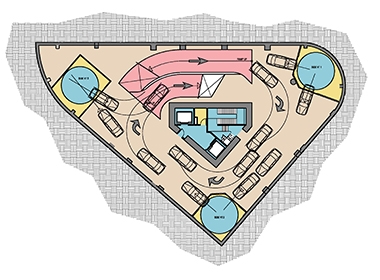 Site plan for project utilizing a mechanical & automated parking system
Site plan for project utilizing a mechanical & automated parking system
Evaluating Performance Needs
In addition to deciding how you want your user base to interact with the system, it’s important to establish how the system needs to perform to accommodate the user’s needs. Some systems have lower capacity and throughput capabilities, which can affect how quickly users can drop off and pick up their vehicles. Parking that services office space, for example, needs to be able to handle high volumes during peak hours, while public parking at a mixed-use project might have a steadier flow of vehicles.
Another important component that is critical to success is establishing an alternative parking plan for patrons when a system is out of service. Power outages, emergency maintenance, and other unforeseen circumstances are uncommon, but can occur. Developing an efficient process that minimizes the disruption to users can significantly impact customer satisfaction and help them know what to do should an event occur.
These factors alone can make choosing the right system challenging, and often there are additional layers that can add even more complexity. For instance, many developments cater to multiple uses, which can make choosing a system more complicated as different user groups may have different needs, peak hours and knowledge levels when it comes to operating a system.
The good news is, because these systems are highly adaptable, there are countless ways they can be customized to fit a project’s needs. Valet parking has been used extensively to improve the parking experience and can be very effective when integrated with mechanical and automated systems. Not only can valets make parking more user friendly, they can also provide an alternative means to make a slower system more efficient.
The Cost of Mechanical and Automated Parking Solutions
The real cost of mechanical and automated parking goes far beyond the cost of purchasing the system. While these solutions can create enough density to avoid costly subterranean excavations or free up valuable square footage for revenue-driven uses, incorporating the necessary infrastructure to accommodate them can impact upfront construction costs. For instance, most systems require increased floor-to-floor heights over traditional parking structures.
In addition to construction costs, mechanical and automated parking systems have ongoing maintenance needs unique to other parking facilities and require a specialized maintenance provider. In many cases, these solutions also integrate a valet component, which adds additional ongoing expenses. As these systems are becoming more popular, more valet companies are becoming comfortable operating and maintaining them. Understanding the ongoing monthly cost of mechanical and automated parking can be a key factor in deciding what is best for your project.
Finding a Happy Medium
Even once you’ve determined what user experience you want your parking to offer and what your needs are for throughput, capacity and cost, identifying which system is the most effective for a given project can be a complex process. There are a number of different types of systems available and dozens of variations among manufacturers, nearly all of which come with some degree of flexibility and customization.
To better understand what types of systems are available and how they function, we need to break down and define their key characteristics. While the information and resources available through Watry Design will utilize the categorizations you see below, it’s important to keep in mind that in this rapidly growing industry some of the terminology has not yet been standardized and may vary both geographically and by vendor.
Classifying Mechanical and Automated Systems
Mechanical and automated parking is a broad term that refers to mechanized parking solutions, from simple mechanical lifts to fully robotized equipment that requires virtually no human interaction to operate.
There are two basic ways to categorize mechanical and automated parking systems. The first is by looking at how a car is delivered into the system. Mechanical stacker systems and semi-automated systems require the user or a valet to park the vehicle inside the system. The driver parks the car in the space where it will be stored, even if that space is not its permanent location. For instance, a driver might park their car on a mechanical stacker, sliding pallet or semi-automated system that can then be shifted vertically and/or horizontally. With a fully automated system on the other hand, the user leaves the car at the front end of the system, usually in a transfer cabin, and never actually enters the parking system itself. The system is responsible for selecting an available space, storing and later retrieving the vehicle.
A second way to classify these systems is by how cars are accessed within the system. A system is considered dependent when accessing a car or empty space requires a human to move another car. For example, in order to retrieve a vehicle suspended by a mechanical lift that can only be raised or lowered, the car below must be manually moved. Because of this, dependent systems often incorporate a valet solution to facilitate the process.
Independent systems do not require a human to physically move a car to reach a parked or suspended vehicle. For example, a system that utilizes pallets with horizontal and vertical movement is capable of mechanically moving a vehicle left or right in order to access a car stored above it, without requiring a human to physically move a car out of the way.
As a rule, semi-automated and fully automated solutions are independent systems while mechanical stacker systems can be dependent or independent. Understanding how this impacts operations as well as user experience is key to selecting the right system.
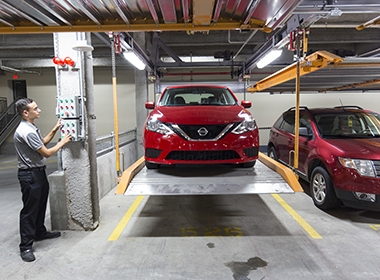 Valet-operated stacking system at a residential development in Wichita, KS
Valet-operated stacking system at a residential development in Wichita, KS
A Closer Look at Mechanical Stacker & Semi-Automated System
Though there are a wide variety of stacking systems available, they all utilize a similar concept: a driver parks a car on a pallet or mechanical lift that is then moved to another location. Stackers can take advantage of vertical or even horizontal space, and provide a means to utilize previously inaccessible areas, such as the space over a drive aisle. These systems tend to be simpler with lower costs and lower maintenance than fully automated structures, but require direct human intervention to select where the vehicle will be stored. Because humans are still present within the parking system, infrastructure similar to that of traditional parking structures, such as ventilation, drive aisles, etc., must still be incorporated into the design. Shallow, sloping floors and higher floor-to-floor heights are required to accommodate equipment.
As throughput can be slower than in other systems, stacking systems are well-suited to residential developments, office campuses or auto dealerships with lower turnover rates. However, integrating a valet program can make these systems operate faster and more efficiently and make them more user-friendly to additional user groups, such as public parking or hotel guests.
Types of Stackers
Dependent Stackers – One of the most common stacking systems is the dependent stacker. This system utilizes mechanical lifts to store a car on top of another car. As these lifts are only capable of being raised or lowered, accessing the car stored above requires human intervention to move the car below. Therefore, this system is best utilized in conjunction with an integrated valet program.
Independent Stackers – Like the dependent stacker, this system involves mechanical lifts that raise and lower. However, independent stackers utilize a below grade “pit” that makes it possible to retrieve a car without moving another car. To access a raised vehicle, the car below it can be lowered into the pit, placing the car above it at ground level.
Independent Sliding Pallet – This is a similar concept to the dependent stacker, only it takes advantage of horizontal space rather than vertical. Therefore, if your project has limited vertical clearance but additional floor space, on-grade pallets allows for tandem parking or even storing vehicles in the drive aisle. Because it is independent, it does not require a person to move a car in order to reach another car.
The above three systems put the safety in the hands of the person using the equipment. The safety gates can be installed as an option, but we rarely see that condition.
Semi-Automated System (Lift & Slide/Puzzle Lift) – This independent system incorporates both vertical and horizontal movements in order to move and store cars. In order to ensure that all cars are accessible independently, one space is always left empty to allow cars to shift. A valet program is not required, however without one users need to be trained in order to operate the system safely. Therefore, it is most effective in residential or office developments that have a consistent user base.
These systems have security gates to provide safety during the operation of the system.
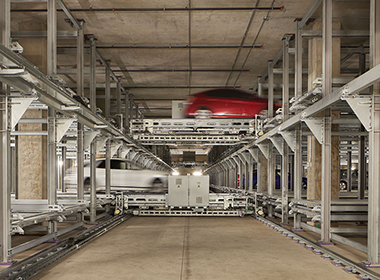 Fully automated parking system
Fully automated parking system
A Closer Look at Fully Automated Systems
While fully automated systems differ in how they move and store vehicles, they all share one thing in common: the transfer cabin. Instead of parking their car on a lift or a pallet that is then transferred to a different location, users drop their vehicle off inside a transfer cabin. From this point, the system is responsible for selecting a space, storing and later retrieving the vehicle. While users are required to follow instructions to activate the system and park the car, the interface is designed to be friendly to first-time users. Special training is not required, making this a viable option for retail and public parking.
Fully automated systems can cost significantly more than stackers, but are capable of providing significantly higher capacity and greater density. As retrieval times are limited by the system’s speed and number of transfer cabin, understanding the throughput and capacity needs of a project is vital, especially if peak demand times such as office shift changes or residential weekday commutes must be accommodated.
Types of Fully Automated Systems
Rack & Rail – The Rack & Rail system transfers a vehicle from a transfer bay via a robotic shuttle. Different manufacturers offer different methods of moving a car to a storage space, some with and some without the use of a pallet. One method utilizes a traveling tower that retrieves a car from the transfer bay and can move both horizontally and vertically to deliver it to a storage space.
As some fire departments do not support the large open shaft required for a traveling tower, a variation places lifts at the end of the aisle way to move vehicles vertically in a much smaller shaft. A depressed slab is added below the aisle way to alleviate fire safety concerns. Another system variation may lift vehicles vertically directly from the transfer bay. Each variation will suit different ownership preferences, fire concerns and throughput needs and should be carefully considered to see if they will meet the right expectations.
XY Palleted – XY Palleted systems function much like lift and slides or puzzle lifts, only a human does not need to enter the system. A pallet retrieves the car from the transfer bay and moves cars horizontally and/or vertically in order to find an open space. Because it does not require an open shaft like the Rack & Rail, it can make more efficient use of volume as only a handful of spaces need to remain empty to provide full access to all vehicles. As with all fully automated systems, retrieval times are limited by the number of transfer bays, but pallet systems are further impacted by the need to move additional vehicles in order to access the desired car.
Automated Guided Vehicle System (AGV) – An AGV system utilizes autonomous, battery operated mobile robots that store vehicles on platforms. This system can provide more flexibility than other fully automated solutions, as the robots are free moving and do not require fixed rails or tracks. However, it does typically command a higher cost depending on throughput requirements and the number of robots needed.
Putting it All Together
Putting all the pieces together to create a mechanical or automated system that is user friendly, cost effective and provides the right levels or performance is not a simple task, but through careful study and thoughtful implementation, they can provide an incredibly successful parking solution.
If you would like to further explore mechanical and automated parking solutions, one of our experts would be happy to assist.


